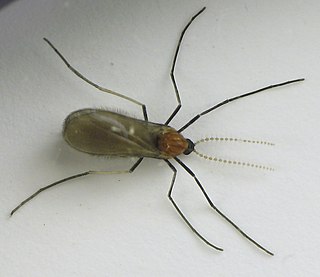
Cecidomyiidae is a family of flies known as gall midges or gall gnats. As the name implies, the larvae of most gall midges feed within plant tissue, creating abnormal plant growths called galls. Cecidomyiidae are very fragile small insects usually only 2–3 mm (0.079–0.118 in) in length; many are less than 1 mm (0.039 in) long. They are characterised by hairy wings, unusual in the order Diptera, and have long antennae. Some Cecidomyiids are also known for the strange phenomenon of paedogenesis in which the larval stage reproduces without maturing first. In some species, the daughter larvae consume the mother, while in others, reproduction occurs later on in the egg or pupa.

Asphondylia is a cosmopolitan genus of gall midges in the family Cecidomyiidae. All species in this genus induce galls on plants, especially on flowers and flower buds. There are over 300 described species in Asphondylia, with many more likely to be discovered and described, especially in the southern hemisphere.

Rhopalomyia is a genus of gall midges, insects in the family Cecidomyiidae. There are at least 267 described species in Rhopalomyia. Most species in this genus induce galls on plants in the Asteraceae. This genus has a cosmopolitan distribution. Rhopalomyia was first established by Ewald Heinrich Rübsaamen in 1892.
Rhopalomyia baccharis, the coyote brush twisted stem gall midge, is a species of gall midges, insects in the family Cecidomyiidae.

Rhopalomyia pomum, the sponge gall midge, is a species of gall midges, insects in the family Cecidomyiidae. The midges form leaf galls on Great Basin sagebrush.

Rhopalomyia anthophilathe Downy Flower Gall Midgeis a species of gall midges, insects in the family Cecidomyiidae. It induces galls on the host Solidago altissima across much of North America.

Rhopalomyia californica, the coyote brush bud gall midge, is a species of gall midges, insects in the family Cecidomyiidae.

Rabdophaga rigidae, the willow beaked-gall midge, is a species of gall midge in the family Cecidomyiidae. It is found across North America. Some sources state that it is also present in parts of eastern Asia including Japan; however, a 2006 study shows that the Asian populations likely represent a separate species: Rabdophaga salicivora.

Rhopalomyia solidaginis, the goldenrod bunch gall, is a species of gall midges, insects in the family Cecidomyiidae The galls of this species have the following host species of goldenrods:Solidago altissima, Solidago canadensis, Solidago rugosa They have been found across eastern North American.

Rhopalomyia audibertiae, the sage leaf gall midge, is a species of gall midges, insects in the family Cecidomyiidae.

Asphondylia solidaginis is a species of gall midge (Cecidomyiidae) that induces galls on goldenrods in North America where it is widespread. It was first described by William Beutenmuller in 1907.
Rhopalomyia chrysothamni is a species of gall midges, insects in the family Cecidomyiidae. The midge causes very small, conical-tubular stem galls on rubber rabbitbrush [Ericameria nauseosa].

Rhopalomyia hirtipes is a species of gall midges, insects in the family Cecidomyiidae. They are found in the eastern part of North American on buds and stems of Solidago juncea
Rhopalomyia grossulariae, the gooseberry gall midge, is a species of gall midges, insects in the family Cecidomyiidae.
Rhopalomyia ericameriae is a species of gall midges, insects in the family Cecidomyiidae.

Rhopalomyia clarkei is a species of gall midges, insects in the family Cecidomyiidae. The larvae induce galls on two hosts: Solidago altissima and Solidago rugosa and are found in north-eastern and north central North America.
Rhopalomyia lateriflori is a species of gall midge, insects in the family Cecidomyiidae.
Rhopalomyia astericaulis is a species of gall midges, insects in the family Cecidomyiidae.

Rhopalomyia capitata, the giant goldenrod bunch gall, is a species of gall midge in the family Cecidomyiidae. It is found across North America. They have been collected from Solidago canadensis, Solidago gigantea, and Solidago leavenworthiigallormers species page
Rhopalomyia thompsoni is a species of gall midges, insects in the family Cecidomyiidae. It induces galls on the host Solidago altissima across much of North America.












